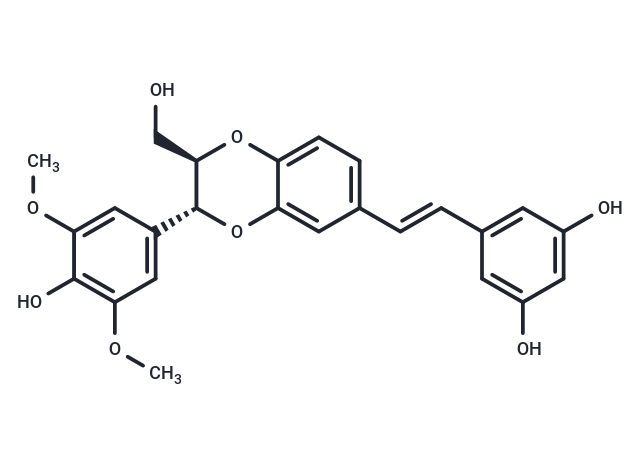Shopping Cart
- Remove All
 Your shopping cart is currently empty
Your shopping cart is currently empty

(±)-Aiphanol, a newly identified stilbenolignan analog, demonstrates notable anti-inflammatory properties by inhibiting COX-1 and COX-2. It shows a robust inhibitory effect on COX-1 (IC 50 = 1.9 μM) and a milder effect on COX-2 (IC 50 = 9.9 μM) [1]. Additionally, (±)-Aiphanol effectively inhibits VEGFR2 with an IC 50 of 0.92 µM, blocking angiogenesis and inducing apoptosis through VEGFR2 and COX2 inhibition. It is also orally active [2].

| Pack Size | Price | Availability | Quantity |
|---|---|---|---|
| 10 mg | Inquiry | Inquiry | |
| 50 mg | Inquiry | Inquiry |
| Description | (±)-Aiphanol, a newly identified stilbenolignan analog, demonstrates notable anti-inflammatory properties by inhibiting COX-1 and COX-2. It shows a robust inhibitory effect on COX-1 (IC 50 = 1.9 μM) and a milder effect on COX-2 (IC 50 = 9.9 μM) [1]. Additionally, (±)-Aiphanol effectively inhibits VEGFR2 with an IC 50 of 0.92 µM, blocking angiogenesis and inducing apoptosis through VEGFR2 and COX2 inhibition. It is also orally active [2]. |
| Targets&IC50 | VEGFR2:0.92 μM, COX-2:9.9 μM, COX-1:1.9 μM |
| In vitro | (±)-Aiphanol, at concentrations of 7.5-30 μM over 6 hours, hinders VEGF-induced angiogenesis in HUVECs in a dose-dependent manner, notably reducing PGE2 and VEGF levels, with these effects nullified upon COX2 silencing. It surpasses Celecoxib in inhibiting VEGF-induced tubular structure formation in HUVECs [2]. In addition, (±)-Aiphanol significantly suppresses microvascular growth in the CAM assay, comparable to Bevacizumab [2]. The compound also inhibits VEGFR3/FLT4, VEGFR2/KDR, and VEGFR1/FLT1 activity while exerting moderate or weak inhibition on certain kinases in the PI3K-AKT and MAPK pathways [2]. At 30 μM over 24 hours, (±)-Aiphanol restricts HUVEC proliferation and induces apoptosis [2]. Apoptosis Analysis [2] Cell Line: HUVECs Concentration: 30 μM Incubation Time: 24 h Result: Did not alter cell cycle distribution significantly but markedly increased apoptosis, with elevated P53 and BAX protein expression. |
| In vivo | (±)-Aiphanol, administered orally at 30 mg/kg as a single dose, effectively inhibits tumor growth and significantly reduces tumor weight in the MC38 syngeneic mouse model [2]. This treatment enhances apoptosis in tumor tissues and decreases the phosphorylation of VEGFR2, AKT, and ERK. It also significantly reduces levels of vascular markers CD31 and factor VIII, as well as PGE2 in plasma and VEGF in tumor tissues. No changes were observed in body weight or the morphology of major organs. |
| Alias | Aiphanol |
| Molecular Weight | 452.45 |
| Formula | C25H24O8 |
| Cas No. | 578020-29-8 |
| Storage | Powder: -20°C for 3 years | In solvent: -80°C for 1 year | Shipping with blue ice. |

Copyright © 2015-2025 TargetMol Chemicals Inc. All Rights Reserved.